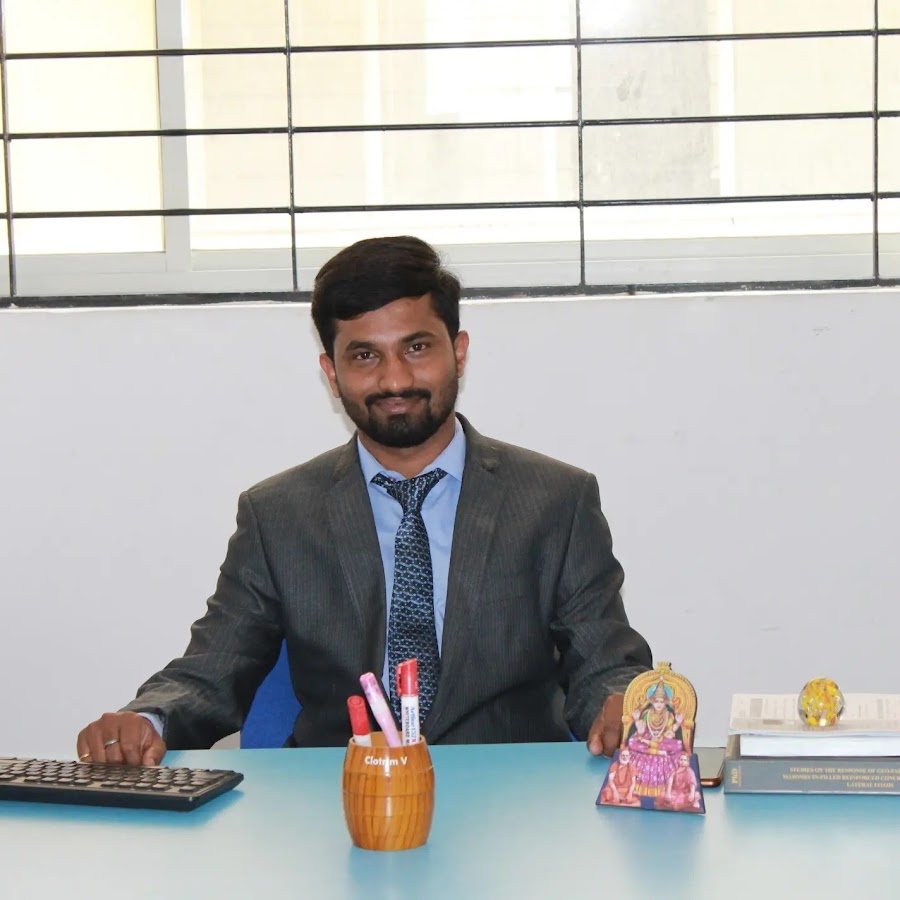Dr. Sreekeshava K S
@jyothyit.ac.in
Associate Professor & Head, Department of Civil Engineering
Jyothy Institute of Technology, Bangalore-560082
K S has more than nine year of teaching experience and works as an Associate Professor. His works on Earthquake Engineering, Concrete Technology, soil-Structure Interaction, Application of GIS in Water Resources Engineering and Masonry Structures are published in various international journals. He has published more than 40 publications which includes springer and Taylor Francis book chapters. He has written more than 10 book chapters and presented technical papers in national/international conferences. In his short duration of teaching experience he has authored two books including “Elements of Civil Engineering and Engineering Mechanics” and “Mechanics of materials. He has guided more than 12 UG projects sponsored by Karnataka State Council for Science and Technology (KSCST), Bangalore from 2015 to 2021. He has the honors' of life member of ISTE, ICI, INSC, NICEE and IAENG.
EDUCATION
Doctor of Philosophy - PhD at Visvesvaraya Technological University (BMSCE) in Civil Engineering & Sciences.
Post Graduation- M.tech at Visvesvaraya Technological University (NCET) in Structural Engineering.
Under Graduation- B.E at Visvesvaraya Technological University (Government Engineering College-Hassan) in Civil Engineering.
RESEARCH INTERESTS
Masonry Structures, Bio-composites, Concrete Structures, Steel Structures, Structural Design, Finite Element Analysis, Matrix method of structural analysis, Structural Dynamics, Earthquake Resistant Design, Water resources Engineering, Environmental Engineering, Interdisciplinary developments
Scopus Publications
Scholar Citations
Scholar h-index
Scholar i10-index
Scopus Publications
A. R. Nagalakshmi, A. S. Shrikanth, G. K. Kalavathi, and K. S. Sreekeshava
MDPI AG
The incidence of edges on vertices is a cornerstone of graph theory, with profound implications for various graph properties and applications. Understanding degree distributions and their implications is crucial for analyzing and modeling real-world networks. This study investigates the impact of vertex degree distribution on the energy landscape of graphs in network theory. By analyzing how vertex connectivity influences graph energy, the research enhances the understanding of network structure and dynamics. It establishes important properties and sharp bounds related to degree spectra and degree energy. Furthermore, the study determines the degree spectra and degree energy for several key families of graphs, providing valuable insights with potential applications across various fields.
Sreevalsa Kolathayar, N Vinod Chandra Menon, and Sreekeshava K S
CRC Press
N Vinod Chandra Menon, Sreevalsa Kolathayar, and K S Sreekeshava
CRC Press
Sreevalsa Kolathayar, N Vinod Chandra Menon, and K S Sreekeshava
CRC Press
Sreevalsa Kolathayar, K. S. Sreekeshava, N. Vinod Chandra Menon, Poonam Shekhawat, and C. Bhargavi
Springer Nature Singapore
N. Vinod Chandra Menon, Sreevalsa Kolathayar, K. S. Sreekeshava, and C. Bhargavi
Springer Nature Singapore
K. S. Sreekeshava, Sreevalsa Kolathayar, N. Vinod Chandra Menon, and C. Bhargavi
Springer Nature Singapore
K. S. Sreekeshava, Sreevalsa Kolathayar, N. Vinod Chandra Menon, and Bhargavi.C
Springer Nature Singapore
N. Vinod Chandra Menon, Sreevalsa Kolathayar, Hugo Rodrigues, K. S. Sreekeshava, and C. Bhargavi
Springer Nature Singapore
T. Q. K. Lam, K. S. Sreekeshava, C. Bhargavi, C. R. Ganesh, N. S. Ambale, and T. M. D. Do
Hindawi Limited
Wastewater pollution from domestic, industrial, and agricultural sources threatens the environment and human health. Traditional wastewater treatment methods are energy intensive, generate significant sludge, and may not remove all contaminants. This study explores the use of microalgae, Chlorella sorokinianana, to treat wastewater and evaluates its impact on concrete properties. The research aims to optimize microalgae growth conditions, set up nutrient-rich growth chambers, develop biomass separation methods, and assess the effects of microalgae-treated wastewater on concrete. Scanning electron microscopy (SEM) was used to analyze concrete structures produced with microalgae-treated wastewater, freshwater, and sewage treatment plant (STP) water. Concrete from microalgae-treated wastewater exhibited euhedral crystals with pronounced gaps, while freshwater concrete had denser subhedral to anhedral crystals. STP water concrete consistently had lower strength values, possibly due to impurities affecting cement hydration. Microalgae-treated water concrete showed intermediate strength levels, suggesting organic or biological factors may influence hydration, but it still gained strength with time. This study underscores the potential of microalgae-treated wastewater for sustainable concrete production, highlighting the importance of further research to optimize conditions and promote environmentally friendly construction practices.
Sreevalsa Kolathayar, N. Vinod Chandra Menon, K. S. Sreekeshava, Poonam Shekhawat, and C. Bhargavi
Springer Nature Singapore
N. Shravan, M. Manoj Kumar, Sriraag Jayanth, R. S. Bindu, B. R. Madhu, and K. S. Sreekeshava
Springer Nature Singapore
K. S. Sreekeshava, Hugo Rodrigues, and A. S. Arunkumar
MDPI AG
The interfaces between masonry infill and reinforced concrete (MI-RC) frames are identified as the weakest regions under lateral loads. Hence, the behavior of such frames under lateral loads can be understood mainly through experimental investigations. The deformation demands induced by horizontal loads on RC frames with infill masonry walls change due to contact losses between the infill masonry and the RC frames. This can be controlled by providing proper reinforcements at the interfaces. In the present experimental investigation, three half-scaled models subjected to reversed cyclic lateral in-plane loads were tested. In detail, the specimens considered are the MI-RC frame model, an MI-RC frame with geo-fabric reinforcement at the interface and an MI-RC frame with geo-fabric reinforcement at interfaces with an open ground story. The models were subjected to reversed cyclic lateral in-plane loads, and the post-yield responses of the models with respect to stiffness degradation, drift, energy dissipation, ductility and failure mode have been discussed.
C.R. Ganesh, J. Sumalatha, K.S. Sreekeshava, and K. Sharath
Elsevier BV
Jagadish Vengala, Manish S. Dharek, Prashant Sunagar, K. S. Sreekeshava, Kilabanur Pramod, Darshan Baliga, P. S. Haripriya, and Poornachandra Thejaswi
Springer Singapore
Manish S. Dharek, K. S. Sreekeshava, Jagadish Vengala, Kilabanur Pramod, Prashant Sunagar, and M. V. Shivaprakash
Springer Singapore
K.S. Sreekeshava, A.S. Arunkumar, and B.V. Ravishankar
Elsevier BV
Manish S. Dharek, Prashant Sunagar, K. S. Sreekeshava, B. Nagashree, Poornachandra Thejaswi, Pramod Kilabanur, K. Nruthya, and C. Satish Chandra
Springer Singapore

